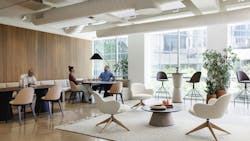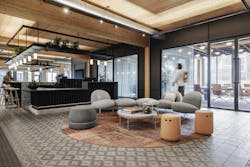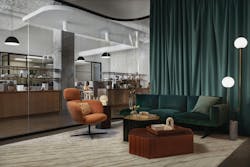Future Workspaces Cultivate Belonging and Foster Emotional Ties
Key Highlights
- Design workplaces with residential elements like soft materials and warm colors to create a familiar, comforting environment.
- Incorporate diverse work zones to accommodate different personality types and work preferences, fostering inclusivity.
- Offer flexible spaces that allow employees to transition between private and social areas, enhancing comfort and productivity.
- Engage employees in feedback and continuous improvement to build authentic emotional connections with the workspace.
- Well-designed, inclusive offices can increase employee loyalty, improve space utilization, and benefit building owners through higher retention.
Humans are creatures of comfort, especially employees who’ve been working remotely over the past few years and have not only adapted to but have grown fond of their makeshift workspaces at home. The 26% of the U.S. workforce working in exclusively remote positions (Gallup, 2025) has developed place attachment, meaning they’ve formed a positive emotional bond with their environment—in this case, their remote workspaces. Having traded in their rigid desks and office task chairs in favor of soft and cozy couches that make them feel safe, remote workers have become accustomed to quieter, more independent work zones. So much so that they’re turning down the option to return to in-person collaborative workplaces.
While employees are enjoying the comforts of working from home, they’re also being distracted by the convenience of it (i.e., doing laundry, running quick errands, walking the dog), all limiting their opportunity for soft skill development, in person mentorship, and the opportunity to create and innovate in a collaborative environment. As the return-to-work conversation continues, there is an emphasis on creating welcoming and inclusive office spaces where employees feel like they belong.
To draw employees back into the workplace, office building owners need to tap into human needs, redesign work environments to cater to people’s diverse needs, and incorporate residential elements that make them feel like they’re at home. By fostering place attachment, employers can reengage and retain employees while optimizing space utilization by creating work locations where hybrid and full-time office employees want to commute daily.
Fostering Place Attachment Through Inclusive Design
When designed with an open and inclusive mindset, the workplace can become a destination where people feel just as comfortable performing tasks in the office as they do while sitting on their couch, and a community where one feels relaxed enough to be themselves. Building owners, facility managers, and companies who own or rent their office space can work with an interior designer to integrate familiar residential elements such as soft materials, rounded furniture, and warmer, organic color palettes while still curating a professional work environment. Personal and nostalgic elements are also a great way to help employees create a positive association with their office, especially as the age of personalized desks is fading away.
Beyond residential aesthetics, strategic layouts and furniture selections are just as important for creating multiple spaces that embrace neurodiversity in the workplace. For instance, some people are introverted and prefer working in private, secluded areas while other workers are extroverted and thrive in socially active environments. By developing workplaces that embrace different work preferences, employees feel respected.
Promote Positivity and Earn Employee Loyalty
While it’s important to provide employees with comforting surroundings, at the end of the day, the office is still a place where work needs to be done. Offering a diverse mix of dynamic private and public work zones allows employees to fluidly transition between different touchpoints throughout the day, moving to quieter or more social spaces as needed. This flexibility lets employees move freely around the office as they would in their home, creating a sense of comfort where people can simply be free and act as themselves. Instead of being restricted by their immutable work personas, employees are happier and feel like they belong. By providing an upgraded and more supportive workplace experience, the satisfied employees will naturally take greater pride in their work and have an increased sense of loyalty, knowing their needs are being met.
Implications for Building Owners and Facility Managers
Thoughtful and inclusive workplace designs not only benefit the employee and the employer, but they also provide a great return for building owners and managers. A well-designed workplace has the power to have employees happily come in the door every day, or the few days a week they report into the office if they’re on a hybrid schedule. Employers are in a position where they want and need to keep their employees contented and engaged, which is difficult to do if they’re constantly moving locations.
Flexible, human-centric office designs featuring local community tie-ins or general areas where employees can add personal elements all culminate to create welcoming, exciting places where people truly want to be. Maintaining these spaces over time and being open to accommodating requests and applying changes in the future will also help support a long-term emotional connection. When employers develop spaces where employees become attached, it increases the possibility of the employer renewing or extending their lease, ultimately benefiting the building owners.
Looking Forward
The deep-rooted psychological effects of a well-designed workplace go beyond conversations involving color, pattern, and texture. Authenticity, being open to receiving feedback, and actively making changes that benefit staff go a long way with employees. When an employer is able to design an office where employees feel as though they truly belong and feel safe, they’re more apt to remain loyal to the company and know they’re being seen, heard, and thoughtfully supported by management.
About the Author
Koorosh Sharghi
Koorosh Sharghi is the president of Studio TK. Applying a people-first approach in his position, Sharghi aims to broaden the brand’s reach within social and collaborative environments while nurturing relationships with employees and clients alike. He has a background in commercial furniture as well as retail-driven consumer brands in a variety of executive capacities.


